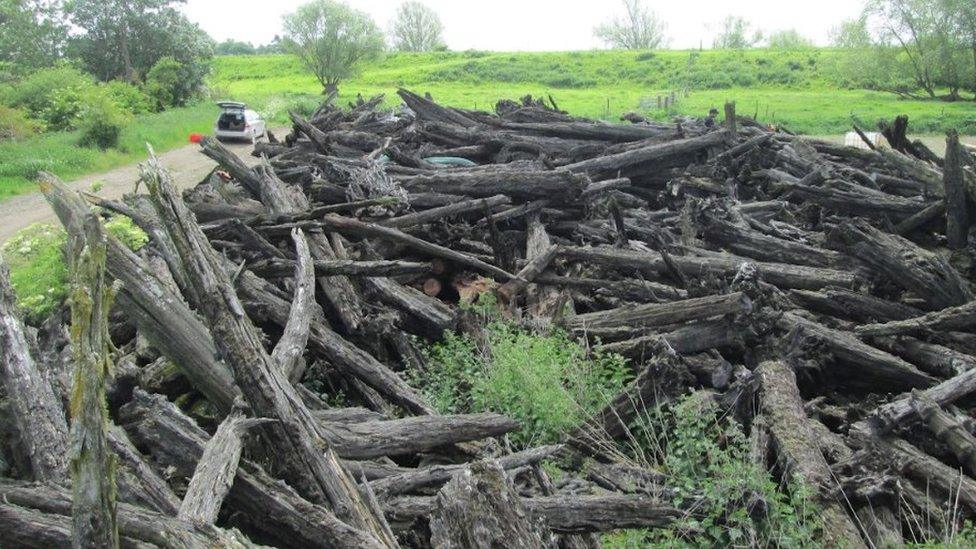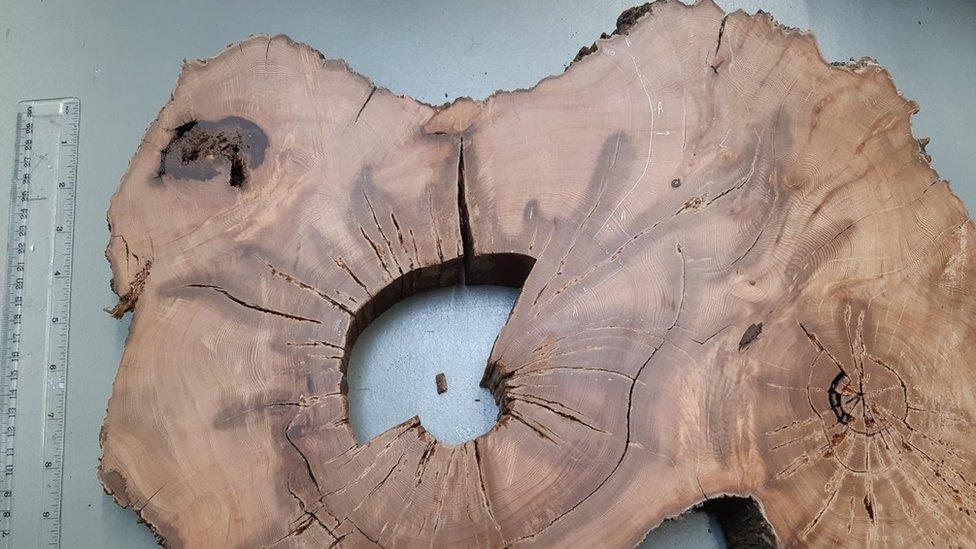Buried ancient Fenland yew trees offer climate change insight
- Published

Pile of subfossil yew trunks on the edge of an agricultural field, north of Peterborough, UK. Photo credit: T. Bebchuk
The buried remains of vast forests of ancient yew trees that once covered the Fens could shed light on the history of climate change, researchers said.
Hundreds of tree trunks dug up by Fenland farmers during ploughing were studied at Cambridge University.
They said the trees were "a unique climate and environmental archive".
It is thought a rapid rise in North Sea levels flooded the area with salt water, causing the woodlands to disappear about 4,200 years ago.
Much of the Cambridgeshire Fens was a wetland until it was drained between the 17th and 19th Centuries using artificial drainage and flood protection.
Today, the area is home to some of the most productive farmland in the UK thanks to its rich peat soil and it is dominated by fields of potatoes, sugar beet, wheat and other crops.
However, its history means that "a common annoyance for Fenland farmers is getting their equipment caught on big pieces of wood buried in the soil, which can often happen when planting potatoes, since they are planted a little deeper than other crops," said Tatiana Bebchuk, a PhD student from the University of Cambridge Department of Geography.
"This wood is often pulled up and piled at the edge of fields," she said.
The team took samples of the logs away, and were surprised by how well-preserved they were - "as if they were cut down just yesterday", she said.

This cross-section of a subfossil yew trunk contains 380 tree-rings, providing the age when it died
Analysis by the Cambridge Tree-Ring Unit found some of the ancient trees were 400 years old when they died, providing "unique climate information for over a millennium from around 5,200 years ago until about 4,200 years ago".
"Finding these very old trees in the Fens is completely unexpected - it would be like turning a corner in rural Cambridgeshire and seeing an Egyptian pyramid - you just wouldn't expect it," said Ms Bebchuk.
She added: "Wood rots and decomposes easily, so you just don't expect a tree that died five or four thousand years ago to last so long."
Researchers said the period when the Fen woodlands died coincided with major climatic changes elsewhere in the world at roughly the same time, including a "megadrought in China and the Middle East [that] was a possible trigger of the collapse of several civilisations".
"We want to know if there is any link between these climatic events," Ms Bebchuk said.
"Are the megadroughts in Asia and the Middle East possibly related to the rapid sea level rise in northern Europe? Was this a global climate event, or was it a series of unrelated regional changes?
"We don't yet know what could have caused these climate events, but these trees could be an important part of solving this detective story."
Professor Ulf Büntgen, the senior author of the study, said: "This is such a unique climate and environmental archive that will provide lots of opportunities for future studies, and it's right from Cambridge's own backyard.
"We often travel all over the world to collect ice cores or ancient trees, but it's really special to find such a unique archive so close to the office."

Follow East of England news on Facebook, external, Instagram, external and X, external. Got a story? Email eastofenglandnews@bbc.co.uk, external or WhatsApp us on 0800 169 1830
Related topics
- Published4 November 2022

- Published23 January 2022
